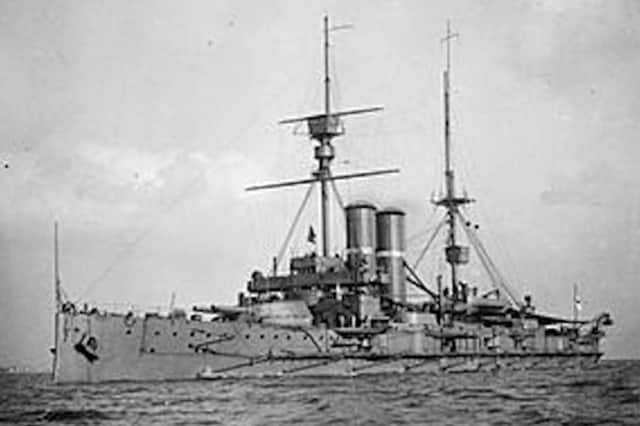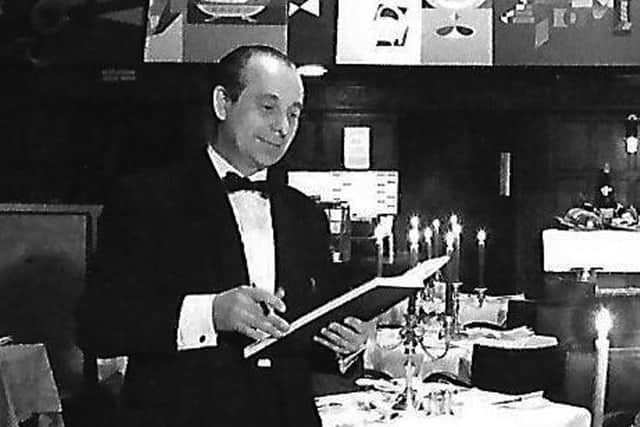You can’t report for duty, you’re dead! – Nostalgia


That’s what happened to sailors who served in the Portsmouth based pre-dreadnought battleship HMS Britannia in 1918. One of the survivors was Gunner William ‘Tom’ Booth the grandfather of David Yates, a volunteer with Portsmouth Anglican Cathedral’s education team.
In October and November with the war drawing to a close, HMS Britannia was supporting convoys to South Africa which brought her into the area of the Straits of Gibraltar.
Advertisement
Hide AdAdvertisement
Hide AdOn November 8, USS Druid and HMS Privet were exchanging fire with U-boat 50, which was on the surface. The submarine got away, but the next day the U-boat captain had Britannia in his periscope sights.


Just after 8am the U-boat fired three torpedoes and one hit the ship aft on the port side. There was a large explosion and a cordite fire started in a magazine. The ship developed a 10-degree list to port. It was too difficult to launch the ship's boats so some of the company transferred to one of the escorting vessels which came alongside. Meanwhile, the ship was full of cordite fumes which claimed 50 sailors’ lives.
Assisting vessels, including HMS Rocksands and HMS Corepsis, transferred the rest of the company from the sinking ship. Eighty wounded were saved, including David's grandfather who had severe burns.
Britannia turned turtle and sank at 11.31am, and remains a war grave. Survivors were taken to Gibraltar.
Advertisement
Hide AdAdvertisement
Hide AdBritannia's company returned to Britain on November 21 and when David’s grandfather reached Portsmouth Naval Barracks he said at the gate: ‘Leading Seaman Booth reporting for duty.' The reply came: ‘Leading Seaman Booth is listed as presumed dead.’ His wife had also been told by letter that he was dead.
Happily he was very much alive and went on to serve in further ships until he retired as a chief petty officer in 1938. He was recalled in 1940 and went back on convoy escort duty aboard HMS Alynbank, an anti-aircraft vessel.
• On January 10, I featured former head waiter in many Portsmouth establishments Henry Bialas with photographs supplied by his son Stephen.
Jon Clapham, of Old Portsmouth, got in touch saying: 'I found your article intriguing. My parents owned and ran the Sally Port Hotel, as it was then known, in the ’60s and ’70s.
Advertisement
Hide AdAdvertisement
Hide Ad‘One of the waiters was called Henry, a Pole who had settled in the UK after the war. He was very conversant with his trade, very helpful and well spoken but absolutely hated the Germans to the point where he would refuse to serve them. He had two sons I believe.’
I asked Stephen about the e-mail and he says: ‘I'm not surprised about his dislike for the Germans as his sister was interned in both Auschwitz camps,and survived. She visited Portsmouth once when I was very young.
'She was stopped by a man in Albert Road who stood in front of her and saluted. She was wearing a sleeveless summer dress and he’d noticed her camp number tattoo. He also had a tattoo. His number was higher than hers meaning she had been in the camps before him.’
• It always amazes me how one article brings back memories for so many, my recent piece about Lake Road being a good example. Godfrey Doyle says: 'I was born and lived in Lake Road from November 1940 until 1963. I lived in Allcroft's Bookshop with my parents and brother and sister. My father inherited the business from his uncle, Mr Allcroft, in the 1930s. The shop specialised in Bibles and supplied many free churches in Portsmouth.
Advertisement
Hide AdAdvertisement
Hide Ad‘It also provided books for Chivers School, in Outram Road and Mile End House School in Commercial Road. It also stocked books for Municipal College students, novels, children's books and fountain pens and inks.
'The shop was opposite Pattenden's shop, a three-storey building which I believe was used for fire-watching in the war. On one side of it was Fields and Marshall, electrical contractors. In their shop window was a model of one of the radar masts they built for the Sussex coast. On the other side was Dittman and Malpas, seed and corn merchants plus garden tools and equipment. The manager would feed the pigeons at closing time.’
Godfrey adds:’Harts Bakery was on one side of the bookshop, a café on the other. The bakery had coal ovens. I remember Dikes and their coal-fired range for the fish and chip shop. All the shopkeepers swept the pavement in front of their shops every day and probably frequently washed it too.'